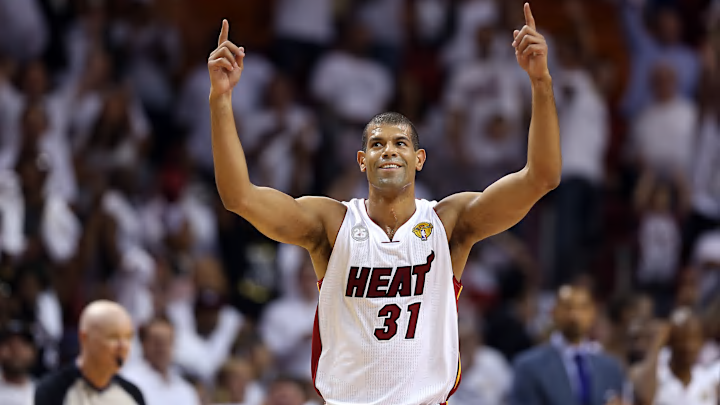Miami Heat champion Shane Battier recently raised concerns about the underlying bias in the NBA Defensive Player of the Year award.
During an episode of "The OGs Show," Battier expressed his reservations to hosts Udonis Haslem and Mike Miller regarding the significant emphasis placed on rim protection.
The Defensive Player of the Year award in the NBA is intended to recognize the top defensive player during the regular season. According to Battier, there is a notable preference for rim protectors, which works in favor of players such as Victor Wembanyama or Chet Holmgren.
Battier and Haslem ultimately believed that Wembanyama deserved the award, while Miller sided with Rudy Gobert. However, Battier presented a compelling argument in favor of the Heat's center, Bam Adebayo, who secured third place in this year’s DPOY voting. He stated on the May 21 episode that Adebayo doesn’t get more praise because his defense can’t be quantified by statistics such as blocks or steals.
"I give Bam all the credit in the world for being able to do what he does without allowing him to really use his strength and his speed," Battier said. "But we can see Wemby, we can see Chet, we can see all these shot blockers. Well, they’re affecting shots, so that’s great defense. So, it’s a matter of perception.”
Previous DPOY Winners
The Defensive Player of the Year award has predominantly been bestowed upon rim protectors, with only five instances where this trend was broken. Among the last 36 winners, the only four non-rim protector exceptions are Gary Payton, Ron Artest, Kawhi Leonard, and Marcus Smart. This fact paints a clear picture: there is an evident inclination that the award typically favors rim protectors, who make up 86.2% of the winners.
These players are the ones who capture the attention with their impressive blocks and steals, while those who excel at disrupting passing lanes and drives often go unnoticed. While players like Gobert may be seen blocking a dunk on SportsCenter, the defensive efforts of players like Herbert Jones or Jrue Holiday in disrupting passing lanes or drives often go unnoticed.
Bias or Perception?
Even the official press release for Gobert's 2023-24 award emphasizes his offensive statistics, such as 14.0 points per game on 66.1% shooting for the Minnesota Timberwolves. The focus on offense is quite telling. It is important to consider that the award is determined by 124 sportswriters and broadcasters who cover the NBA. Human bias plays a role in the decision-making process, and the plays that make it to highlight reels can heavily influence perceptions.
During the May 21 episode of Haslem and Miller’s podcast, Battier highlighted that Adebayo's defensive prowess goes beyond conventional statistics such as blocks or steals, which is why he may not receive as much recognition as he deserves.
"There’s a bias towards guys who are bone-up defenders," Battier said. "The perception now with the league and with the way the rules are — it’s different than when we played — but people don’t get the credit for being able to bone up because A, you can’t be that physical anymore, right? So if you say he’s a one-on-one defender, well, you really can’t stop anybody anymore. You can slow people down, right? So you don’t get credit and so that’s why people don’t credit Bam, which I think he should, because he can switch and guard anybody and do a good job, which not a lot of guys can do in these rules where you can’t be physical.”
“He can literally switch and guard anybody and do a good job”
— The OGs Show (@theOGsShow) May 21, 2024
Watch full episode here: https://t.co/qQuutLt7ag pic.twitter.com/Ksgn5mO6KR
Luckily, Defensive Statistics Are Improving
Before the advent of advanced statistics and tracking, the only means of giving players statistical credit was through blocks, steals, and overall team defense. However, the assessment of player performance has undergone a significant transformation with advancements in technology, including the implementation of sophisticated statistics and tracking methods.
Rather than just emphasizing impressive statistics such as blocks, steals, and team defense as a whole, analysts can now factor in metrics such as defended field goal percentage (both by zone and overall), deflected passes, box outs, etc.
Among players who participated in a minimum of 50 games, Draymond Green emerged as the leader in defended field goal percentage difference, with a remarkable -6.6. Gobert followed closely behind at -6.0, while Adebayo ranked 8th with a difference of -5.1.
Holmgren secured the 11th spot with a difference of -4.4, and Wembanyama claimed the 12th position with a difference of -4.3. When we narrow down the results to shots taken within six feet, Gobert (5th), Holmgren (8th), and Wembanyama (11th) all make appearances. Adebayo, on the other hand, ranked 52nd in this category. However, it is important to note that defense encompasses more than just these statistics. Box outs, for instance, are often overlooked.
While it may not be as glamorous as securing the rebound oneself, preventing the opponent from grabbing the ball is a crucial aspect of a successful defensive stand. Adebayo excelled in this area, ranking 2nd in the NBA with an average of 3.1 box outs per game, just ahead of Gobert's 2.8.
Adebayo's inclusion in the Defensive Player of the Year discussion was inevitable, but his defense was sometimes undervalued and disregarded this season. Battier's argument about the voters underestimating Bam’s ability to guard players across all positions carries significant importance.
This discussion also highlights that implementing a more equitable assessment method in the criteria in the NBA would lead to a more precise selection of the rightful recipient of the DPOY award.
